Hybrid T-Shaped Sensor Array Composed of Acoustic Vector Sensors and Scalar Sensors
Abstract
:1. Introduction
2. Hybrid T-Shaped Sensor Array
3. Tensor Model for Hybrid T-Shaped Sensor Array
3.1. Virtual URA with Acoustic Vector Sensors
3.2. Maximization of DOF
3.3. Two-Dimensional Angle Estimation via an Extended-Aperture Hybrid T-Shaped Sensor Array
| Algorithm 1. Summary of the proposed algorithm. |
| Input: and of the Equations (1) and (2) in Equations (4) and (6) , and build Maximize DOF for from Equations (11) to (17) and build Conduct CP decomposition on and obtain two sets of DOA estimation from and Resolve cyclic ambiguity to obtain accurate estimates. |
4. Numerical Simulation
4.1. Identifiability of the Proposed Method
4.2. RMSE vs. SNR
4.3. RMSE vs. N
4.4. Runtime vs. the Number of Sensor Components
5. Conclusions
Author Contributions
Funding
Data Availability Statement
Conflicts of Interest
References
- Krim, H.; Viberg, M. Two decades of array signal processing research: The parametric approach. IEEE Signal Process. Mag. 1996, 13, 67–94. [Google Scholar] [CrossRef]
- Zheng, Z.; Fu, M.; Wang, W.-Q.; Zhang, S.; Liao, Y. Localization of mixed near-field and far-field sources using symmetric double-nested arrays. IEEE Trans. Antennas Propag. 2019, 67, 7059–7070. [Google Scholar] [CrossRef]
- Wang, X.; Wan, L.; Huang, M.; Shen, C.; Han, Z.; Zhu, T. Low-complexity channel estimation for circular and noncircular signals in virtual MIMO vehicle communication systems. IEEE Trans. Veh. Technol. 2020, 69, 3916–3928. [Google Scholar] [CrossRef]
- He, W.; Yang, X.; Wang, Y. A high-resolution and low-complexity DOA estimation method with unfolded coprime linear arrays. Sensors 2019, 20, 218. [Google Scholar] [CrossRef] [PubMed] [Green Version]
- Aboumahmoud, I.; Muqaibel, A.H.; Alhassoun, M.; Alawsh, S.A. A Review of Sparse Sensor Arrays for Two-Dimensional Direction-of-Arrival Estimation. IEEE Access 2021, 9, 92999–93017. [Google Scholar] [CrossRef]
- Pal, P.; Vaidyanathan, P. Nested arrays in two dimensions, part II: Application in two dimensional array processing. IEEE Trans. Signal Process. 2012, 60, 4706–4718. [Google Scholar] [CrossRef]
- Vaidyanathan, P.P.; Pal, P. Sparse sensing with co-prime samplers and arrays. IEEE Trans. Signal Process. 2010, 59, 573–586. [Google Scholar] [CrossRef]
- Qin, S.; Zhang, Y.D.; Amin, M.G. Two-dimensional DOA estimation using parallel coprime subarrays. In Proceedings of the 2016 IEEE Sensor Array and Multichannel Signal Processing Workshop (SAM), Rio de Janeiro, Brazil, 10–13 July 2016; pp. 1–4. [Google Scholar]
- Zheng, W.; Zhang, X.; Zhai, H. Generalized coprime planar array geometry for 2-D DOA estimation. IEEE Commun. Lett. 2017, 21, 1075–1078. [Google Scholar] [CrossRef]
- Zheng, Z.; Mu, S. Two-dimensional DOA estimation using two parallel nested arrays. IEEE Commun. Lett. 2019, 24, 568–571. [Google Scholar] [CrossRef]
- Si, W.; Zeng, F.; Qu, Z.; Peng, Z. Two-dimensional DOA estimation via a novel sparse array consisting of coprime and nested subarrays. IEEE Commun. Lett. 2020, 24, 1266–1270. [Google Scholar] [CrossRef]
- Dong, Y.-Y.; Dong, C.-X.; Liu, W.; Chen, H.; Zhao, G.-q. 2-D DOA estimation for L-shaped array with array aperture and snapshots extension techniques. IEEE Signal Process. Lett. 2017, 24, 495–499. [Google Scholar] [CrossRef] [Green Version]
- Rao, W.; Li, D.; Zhang, J.Q. A tensor-based approach to L-shaped arrays processing with enhanced degrees of freedom. IEEE Signal Process. Lett. 2017, 25, 1–5. [Google Scholar] [CrossRef]
- Zheng, H.; Shi, Z.; Zhou, C.; Haardt, M.; Chen, J. Coupled Coarray Tensor CPD for DOA Estimation With Coprime L-Shaped Array. IEEE Signal Process. Lett. 2021, 28, 1545–1549. [Google Scholar] [CrossRef]
- Wong, K.T.; Zoltowski, M.D. Extended-aperture underwater acoustic multisource azimuth/elevation direction-finding using uniformly but sparsely spaced vector hydrophones. IEEE J. Ocean. Eng. 1997, 22, 659–672. [Google Scholar] [CrossRef] [Green Version]
- Zoltowski, M.D.; Wong, K.T. ESPRIT-based 2-D direction finding with a sparse uniform array of electromagnetic vector sensors. IEEE Trans. Signal Process. 2000, 48, 2195–2204. [Google Scholar] [CrossRef]
- Yang, M.; Ding, J.; Chen, B.; Yuan, X. A multiscale sparse array of spatially spread electromagnetic-vector-sensors for direction finding and polarization estimation. IEEE Access 2018, 6, 9807–9818. [Google Scholar] [CrossRef]
- He, J.; Zhang, Z.; Shu, T.; Yu, W. Sparse nested array with aperture extension for high accuracy angle estimation. Signal Process. 2020, 176, 107700. [Google Scholar] [CrossRef]
- Liu, S.; Zhao, J.; Zhang, Y.; Wu, D. 2D DOA Estimation Algorithm by Nested Acoustic Vector-Sensor Array. Circuits Syst. Signal Process. 2021, 41, 1115–1130. [Google Scholar] [CrossRef]
- He, J.; Li, L.; Shu, T. Sparse nested arrays with spatially spread square acoustic vector sensors for high-accuracy underdetermined direction finding. IEEE Trans. Aerosp. Electron. Syst. 2021, 57, 2324–2336. [Google Scholar] [CrossRef]
- Yang, M.; Ding, J.; Chen, B.; Yuan, X. Coprime L-shaped array connected by a triangular spatially-spread electromagnetic-vector-sensor for two-dimensional direction of arrival estimation. IET Radar Sonar Navig. 2019, 13, 1609–1615. [Google Scholar] [CrossRef]
- Fu, M.; Zheng, Z.; Wang, W.-Q.; So, H.C. Coarray interpolation for DOA estimation using coprime EMVS array. IEEE Signal Process. Lett. 2021, 28, 548–552. [Google Scholar] [CrossRef]
- Qu, X.; Lou, Y.; Zhao, Y.; Lu, Y.; Qiao, G. Augmented Tensor MUSIC for DOA Estimation Using Nested Acoustic Vector-Sensor Array. IEEE Signal Process. Lett. 2022, 29, 1624–1628. [Google Scholar] [CrossRef]
- Cao, J.; Liu, J.; Wang, J.; Lai, X. Acoustic vector sensor: Reviews and future perspectives. IET Signal Process. 2017, 11, 1–9. [Google Scholar] [CrossRef]
- Rahamim, D.; Tabrikian, J.; Shavit, R. Source localization using vector sensor array in a multipath environment. IEEE Trans. Signal Process. 2004, 52, 3096–3103. [Google Scholar] [CrossRef]
- Nehorai, A.; Paldi, E. Acoustic vector-sensor array processing. IEEE Trans. Signal Process. 1994, 42, 2481–2491. [Google Scholar] [CrossRef]
- Kolda, T.G.; Bader, B.W. Tensor decompositions and applications. SIAM Rev. 2009, 51, 455–500. [Google Scholar] [CrossRef]
- Sidiropoulos, N.D. Generalizing Caratheodory’s uniqueness of harmonic parameterization to N dimensions. IEEE Trans. Inf. Theory 2001, 47, 1687–1690. [Google Scholar] [CrossRef] [Green Version]
- Vervliet, N.; Debals, O.; De Lathauwer, L. Tensorlab 3.0—Numerical optimization strategies for large-scale constrained and coupled matrix/tensor factorization. In Proceedings of the 2016 50th Asilomar Conference on Signals, Systems and Computers, Pacific Grove, CA, USA, 6–9 November 2016; pp. 1733–1738. [Google Scholar]
- Wu, Q.; Sun, F.; Lan, P.; Ding, G.; Zhang, X. Two-dimensional direction-of-arrival estimation for co-prime planar arrays: A partial spectral search approach. IEEE Sens. J. 2016, 16, 5660–5670. [Google Scholar] [CrossRef]
- Kawitkar, R. Performance of different types of array structures based on multiple signal classification (MUSIC) algorithm. In Proceedings of the 2009 5th International Conference on MEMS NANO, and Smart Systems, Dubai, United Arab Emirates, 28–30 December 2009; pp. 159–161. [Google Scholar]
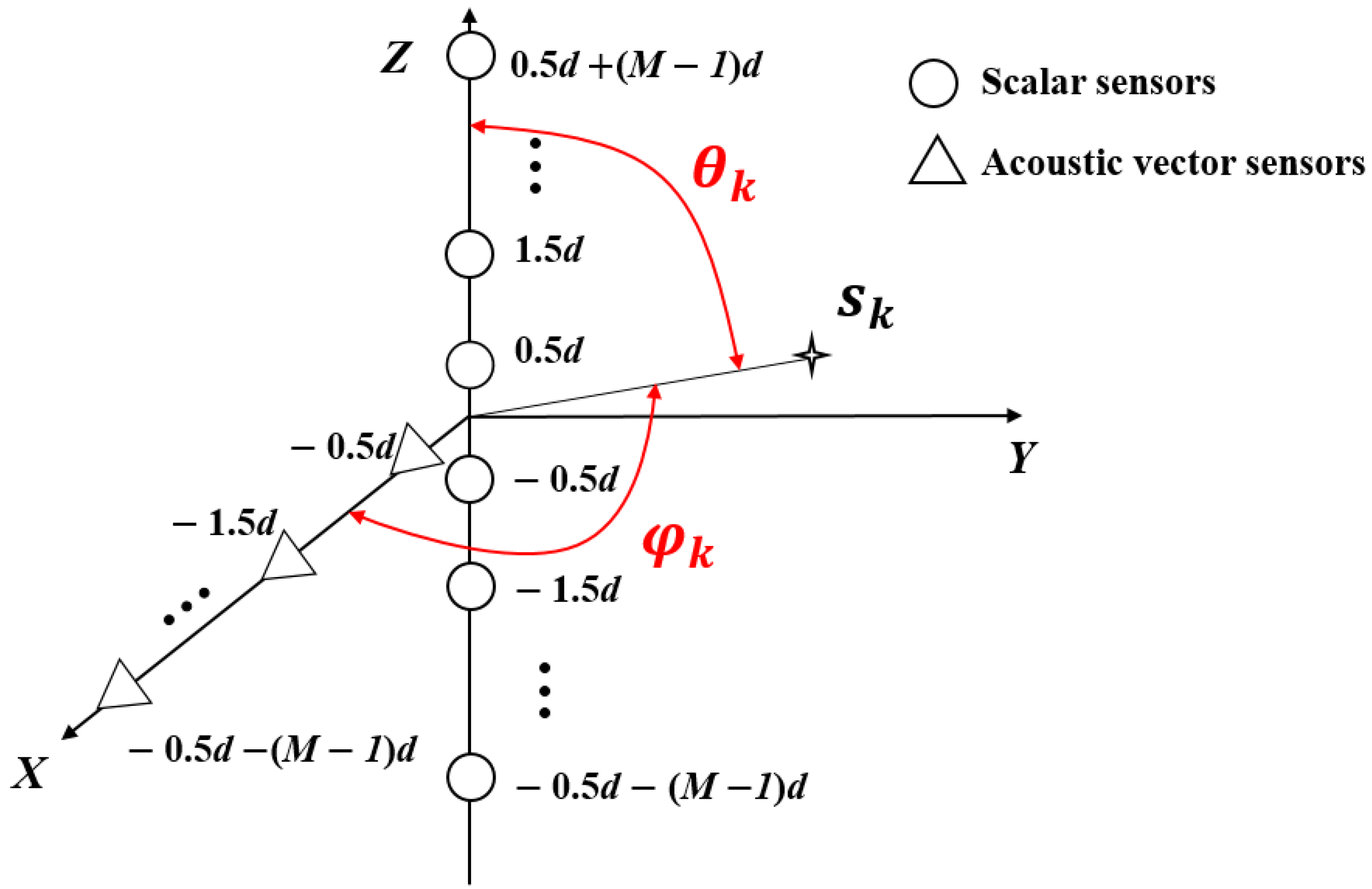
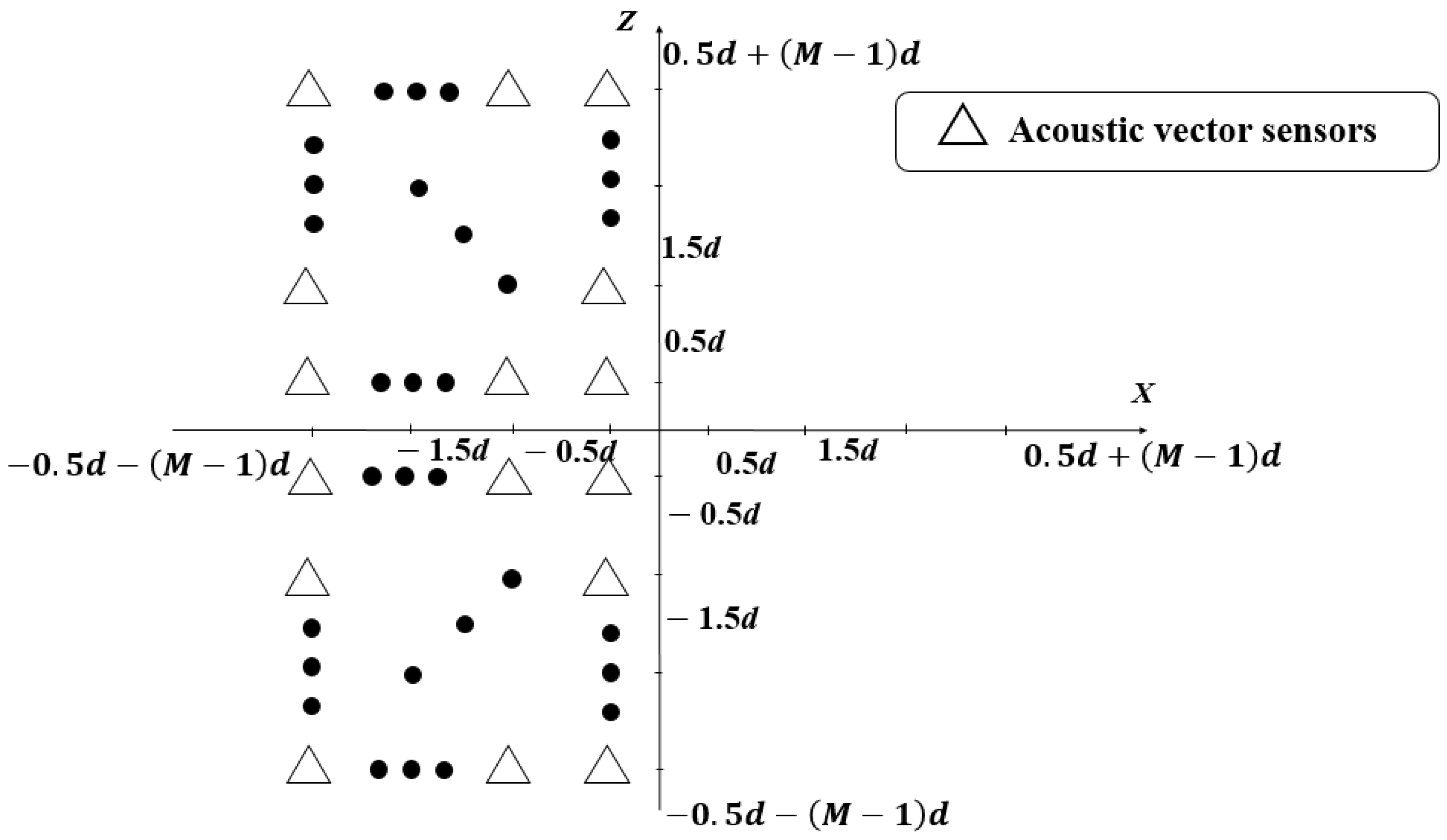



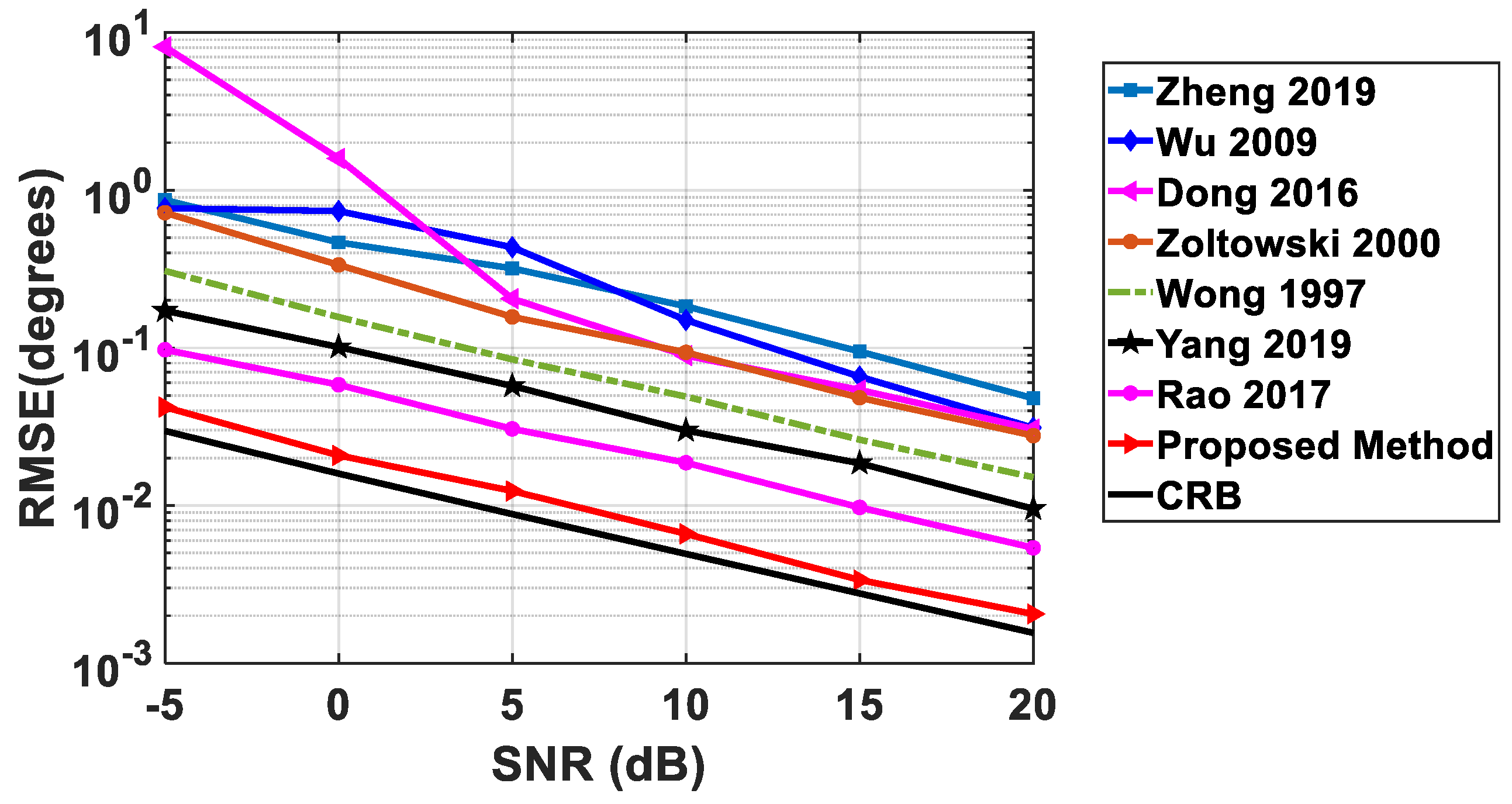
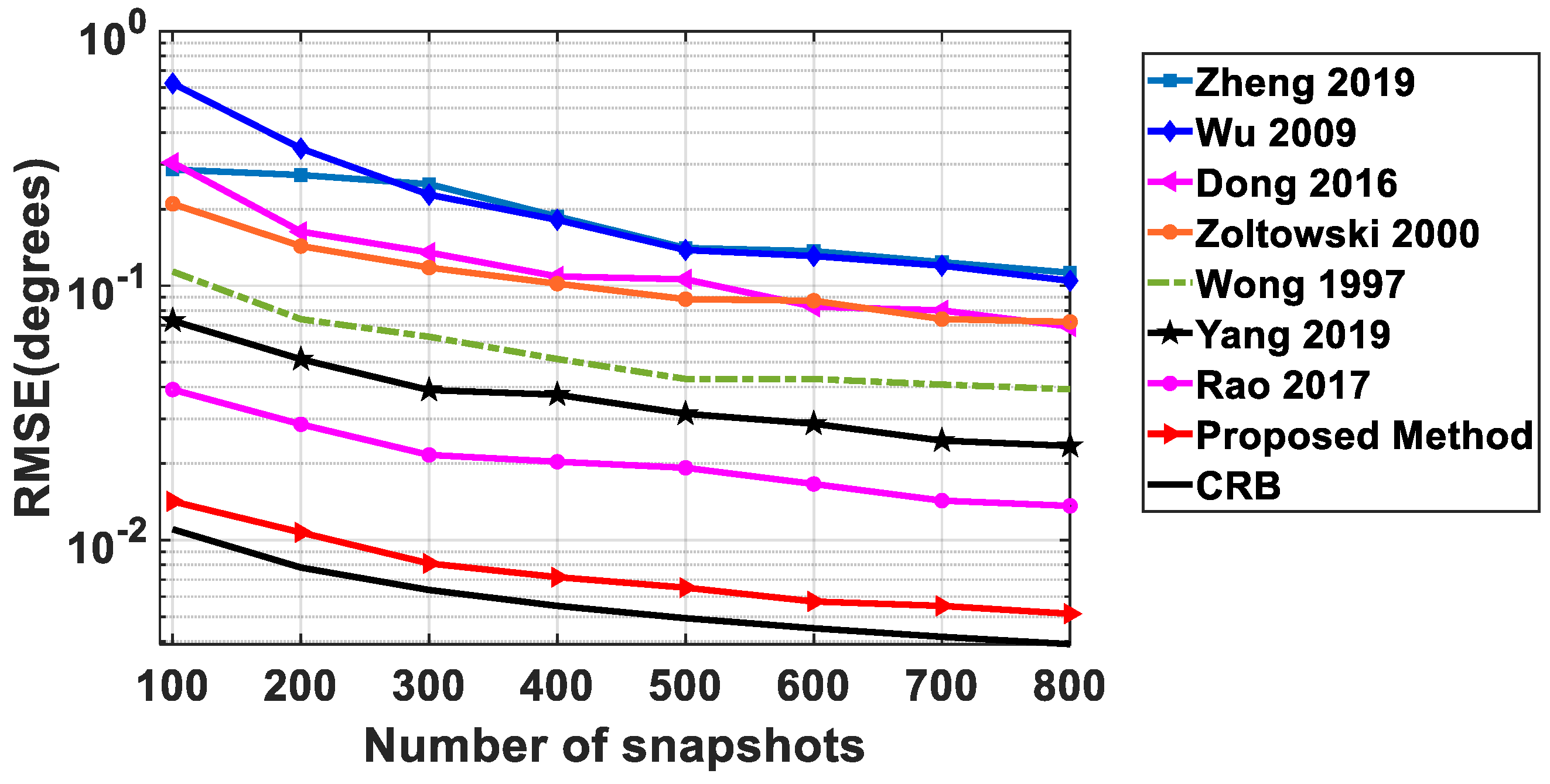
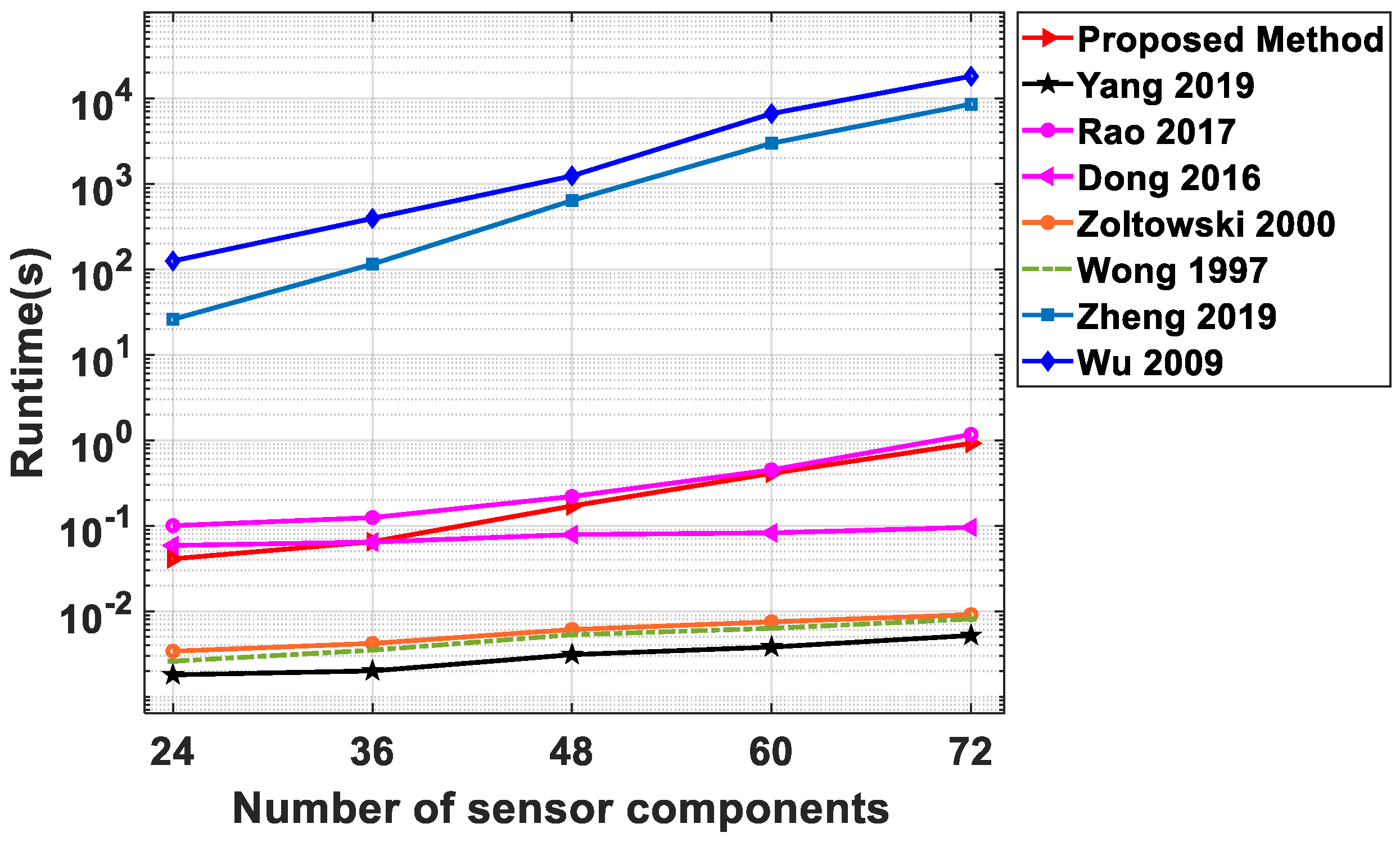
Disclaimer/Publisher’s Note: The statements, opinions and data contained in all publications are solely those of the individual author(s) and contributor(s) and not of MDPI and/or the editor(s). MDPI and/or the editor(s) disclaim responsibility for any injury to people or property resulting from any ideas, methods, instructions or products referred to in the content. |
© 2023 by the authors. Licensee MDPI, Basel, Switzerland. This article is an open access article distributed under the terms and conditions of the Creative Commons Attribution (CC BY) license (https://creativecommons.org/licenses/by/4.0/).
Share and Cite
Rao, W.; Li, Y.; Li, D. Hybrid T-Shaped Sensor Array Composed of Acoustic Vector Sensors and Scalar Sensors. Electronics 2023, 12, 1813. https://doi.org/10.3390/electronics12081813
Rao W, Li Y, Li D. Hybrid T-Shaped Sensor Array Composed of Acoustic Vector Sensors and Scalar Sensors. Electronics. 2023; 12(8):1813. https://doi.org/10.3390/electronics12081813
Chicago/Turabian StyleRao, Wei, Yuanqing Li, and Dan Li. 2023. "Hybrid T-Shaped Sensor Array Composed of Acoustic Vector Sensors and Scalar Sensors" Electronics 12, no. 8: 1813. https://doi.org/10.3390/electronics12081813




